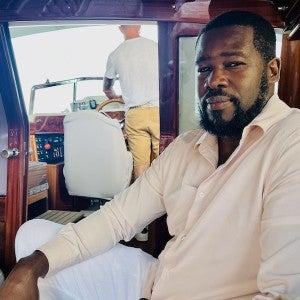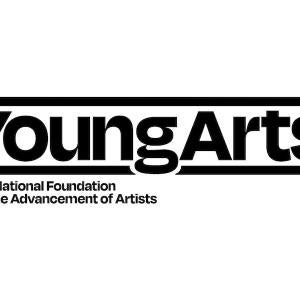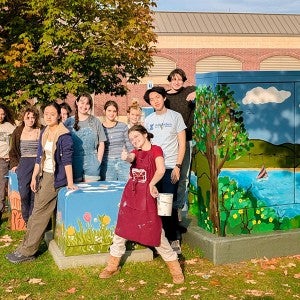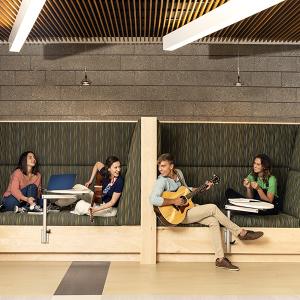Obsolete and out-of-this-world: The art of alumna Julia Christensen
The Guggenheim Fellow explores technological obsolescence—and other solar systems—through art.

Guggenheim Fellow and multidisciplinary artist Julia Christensen. Photo credit: Tanya Rosen-Jones.
As this edition of Crescendo goes to press, NASA is celebrating Voyager 2’s exit from the sun’s heliosphere.
Voyager 2 is a groundbreaking spacecraft in many ways. Among its bevy of scientific instruments, Voyager’s cargo also includes a small golden disc. The Golden Records—one carried by each of the Voyager crafts—contain a variety of natural sounds, images, and musical selections. This content, chosen by a committee chaired by Carl Sagan, is intended as a capsule of information about earth for extraterrestrial life or future humans.
More than 40 years after the Voyager crafts launched, NASA again hopes to reach beyond the solar system with messages from earth. NASA is currently in the preliminary planning stages for a craft that will depart for exoplanet Proxima b in 2069. This craft, too, will carry artwork designed to reveal the human spirit; artwork designed by Interlochen Arts Academy alumna Julia Christensen (IAA 93-94).
Christensen, associate professor in the Studio Art Department at Oberlin College, is a multidisciplinary artist whose work spans photography, electronic music, and writing. Her first book, “Big Box Reuse,” examines ways in which abandoned big box stores have been transformed by their communities. Her current project, “Upgrade Available,” explores our urge to upgrade to new models and forms of technology and abandon our old devices. Christensen is a current Guggenheim fellow and the founder of WAM!—the Women and Art Music ensemble—at Oberlin.
We caught up with Christensen to learn more about her current projects and memories of Interlochen Arts Academy.
Let’s talk a bit about your most recent work, “Upgrade Available.” How did you get interested in technological obsolescence?
In 2011, I was working on another project that took me to India. By a series of strange happenings, I wound up visiting an electronic waste processing center in southern India. I was blown away by what I saw there: 40 tons of electronic trash, most of it imported from the U.S. in the two weeks before my visit. It occured to me that by making artwork that investigates our complex relationships with electronics, I might get a broader understanding of how this “upgrade culture” has emerged.
The impact of obsolescence is everywhere. What are some of the implications that you’re seeing for science, archivism, ecology, and our personal lives?
In our daily lives, the fact that we have computers and hard drives and smart phones all around us kind of puts us on this relentless treadmill. I define upgrade culture as perceived, relentless need to upgrade our electronics and recordable media to stay relevant.
Meanwhile, on an institutional level, it’s become much more difficult to maintain archives and design buildings knowing that upgrade culture is going to continue to change technology over the course of years or decades. With long-term scientific research, it becomes more and more difficult for us to look ahead into the future and plan research that will last the course of 50 or 100 years.
Tell us a bit about the NASA mission that you’re working on.
This is all in proposal stages at the Jet Propulsion Lab in Pasadena, California. They are conceptualizing a spacecraft that will travel to Proxima b, which is 4.2 light years from us. The spacecraft will have to upgrade itself six times in order to survive the environmental conditions of the interstellar journey. It will actually have to autonomously create new physical parts and write its own software.
It will also have to update itself to remain relevant to life on Earth. It takes 42 years to reach Proxima b, and of course, here on Earth, technology will still be changing. We need to be sure that we can still receive the data that it sends back to us. The challenge is to transcend the shorter cycles of time that technology has locked us into to be able to envision technology that will be able to last for decades or generations.
What’s your role in the mission?
NASA has asked me to envision an artwork that will be embedded on this craft. I’m hoping the artwork will mirror those characteristics of transformation and adaptability, and I think that those characteristics also mirror us: how civilization adapts and how our story is actually many, many, many, stories. I’m really interested in thinking about how the design endeavour of the spacecraft itself tells the story about who we are and what we want to learn by exploring the outer reaches of interstellar space.
What media will you use?
In terms of a medium, it’s really hard to say at this point. Making this work in tandem with the design of the spaceship concept means that the medium will be tied to the physicality of the spacecraft. But that said, we’re thinking about generative means of producing an artwork. There could be robots on board that double as artists and make things in response to the atmosphere of the journey. There could be soundwaves; the spaceship could sing as it journeys through space. We are even talking about light waves and how the craft could project a holographic image. It’s pretty wide open at this point.
You’re the founder and director of WAM! (Women in Art Music) at Oberlin. What was your inspiration in founding the ensemble? What do you hope ensemble members take away from the experience of playing in WAM?
I taught for four years in the Technology in Music and Related Arts (TIMARA) department at Oberlin Conservatory. During that time, the electronic music department was heavily male-dominated. I founded WAM as a platform for women to come together to play the music of living women composers, as a means of not only providing an experience, but also to say that we’re here, we’re doing this. It’s certainly one of the most fulfilling things I’ve had a chance to do at Oberlin.
Tell us a bit about your time at Interlochen Arts Academy. What are some of your memories, and some of the things you took away from your time at the Academy?
Looking back, the most important thing might have been finding my people. I came from a small town in central Kentucky, and I knew there were others like me out there who were passionate about the arts, but I hadn’t really met them yet. Finding and working with that community at Interlochen was really important for me.
You're a multidisciplinary artist. Did being surrounded by artists of many disciplines at Interlochen Arts Academy inspire that in any degree?
I’m sure that it did. I was a theatre major at Interlochen, and many of my best friends were creative writing and visual arts majors. After I left Interlochen, I went to Bard College, and I thought that I would be a theatre major. But I started taking electronic music classes and studio art classes. I wound up developing a major at Bard called Integrated Arts, which is structured for students like me who were interested in the intersection between different disciplines. That has been in my work ever since.





